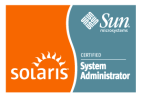Migrate 11.2.0 database from UFS to ASM
Hi,
This post will illustrate steps for migrating datafiles from UFS (or any other file system) to ASM Disk groups.
Step1:
Perform Full Rman Database backup:
Step2:
Shut down and startup database in mount;
Step 3:
Connect database target using rman utility and use command COPY database.
Step 4:
Use command switch database to copy to duplicate your files
Step 5:
Use set new name for tempfile:
Step 6 :
open database with alter database command and verify new location of datafiles
Thanks for reading.....
This post will illustrate steps for migrating datafiles from UFS (or any other file system) to ASM Disk groups.
Step1:
Perform Full Rman Database backup:
Step2:
Shut down and startup database in mount;
SQL> startup mount
ORACLE instance started.
Total System Global Area 1720844288 bytes
Fixed Size 2159024 bytes
Variable Size 1241517648 bytes
Database Buffers 469762048 bytes
Redo Buffers 7405568 bytes
Database mounted.
SQL> exit
Disconnected from Oracle Database 11g Enterprise Edition Release 11.2.0.2.0 - 64bit Production
With the Partitioning, Automatic Storage Management, OLAP, Data Mining
and Real Application Testing options
Step 3:
Connect database target using rman utility and use command COPY database.
bash-3.00$ rman
Recovery Manager: Release 11.2.0.2.0 - Production on Wed Oct 27 13:01:51 2010
Copyright (c) 1982, 2009, Oracle and/or its affiliates. All rights reserved.
RMAN> connect target\
target database Password:
connected to target database: DB1 (DBID=1326750269, not open)
RMAN> BACKUP AS COPY DATABASE FORMAT '+ASMDATA1';
Starting backup at 27-OCT-10
using target database control file instead of recovery catalog
allocated channel: ORA_DISK_1
channel ORA_DISK_1: SID=134 device type=DISK
channel ORA_DISK_1: starting datafile copy
input datafile file number=00001 name=/u01/11g_Home/oradata/db1/system01.dbf
output file name=+ASMDATA1/db1/datafile/system.257.733496553 tag=TAG20101027T130232 RECID=2 STAMP=733496609
channel ORA_DISK_1: datafile copy complete, elapsed time: 00:01:05
channel ORA_DISK_1: starting datafile copy
input datafile file number=00002 name=/u01/11g_Home/oradata/db1/sysaux01.dbf
output file name=+ASMDATA1/db1/datafile/sysaux.258.733496619 tag=TAG20101027T130232 RECID=3 STAMP=733496663
channel ORA_DISK_1: datafile copy complete, elapsed time: 00:00:55
channel ORA_DISK_1: starting datafile copy
input datafile file number=00005 name=/u01/11g_Home/oradata/db1/example01.dbf
output file name=+ASMDATA1/db1/datafile/example.259.733496673 tag=TAG20101027T130232 RECID=4 STAMP=733496690
channel ORA_DISK_1: datafile copy complete, elapsed time: 00:00:25
channel ORA_DISK_1: starting datafile copy
input datafile file number=00003 name=/u01/11g_Home/oradata/db1/undotbs01.dbf
output file name=+ASMDATA1/db1/datafile/undotbs1.260.733496699 tag=TAG20101027T130232 RECID=5 STAMP=733496706
channel ORA_DISK_1: datafile copy complete, elapsed time: 00:00:07
channel ORA_DISK_1: starting datafile copy
copying current control file
output file name=+ASMDATA1/db1/controlfile/backup.261.733496707 tag=TAG20101027T130232 RECID=6 STAMP=733496708
channel ORA_DISK_1: datafile copy complete, elapsed time: 00:00:03
channel ORA_DISK_1: starting datafile copy
input datafile file number=00004 name=/u01/11g_Home/oradata/db1/users01.dbf
output file name=+ASMDATA1/db1/datafile/users.262.733496711 tag=TAG20101027T130232 RECID=7 STAMP=733496710
channel ORA_DISK_1: datafile copy complete, elapsed time: 00:00:01
Finished backup at 27-OCT-10
RMAN>
Step 4:
Use command switch database to copy to duplicate your files
RMAN> SWITCH DATABASE TO COPY;
datafile 1 switched to datafile copy "+ASMDATA1/db1/datafile/system.257.733496553"
datafile 2 switched to datafile copy "+ASMDATA1/db1/datafile/sysaux.258.733496619"
datafile 3 switched to datafile copy "+ASMDATA1/db1/datafile/undotbs1.260.733496699"
datafile 4 switched to datafile copy "+ASMDATA1/db1/datafile/users.262.733496711"
datafile 5 switched to datafile copy "+ASMDATA1/db1/datafile/example.259.733496673"
Step 5:
Use set new name for tempfile:
RMAN> run {
2> set newname for tempfile 1 to '+ASMDATA1';
3> set newname for tempfile 2 to '+ASMDATA1';
4> }
executing command: SET NEWNAME
executing command: SET NEWNAME
RMAN>
Step 6 :
open database with alter database command and verify new location of datafiles
RMAN> ALTER DATABASE OPEN;
database opened
SQL> select name from v$datafile;
NAME
--------------------------------------------------------------------------------
+ASMDATA1/db1/datafile/system.257.733496553
+ASMDATA1/db1/datafile/sysaux.258.733496619
+ASMDATA1/db1/datafile/undotbs1.260.733496699
+ASMDATA1/db1/datafile/users.262.733496711
+ASMDATA1/db1/datafile/example.259.733496673
SQL>
Thanks for reading.....


0 Comments:
Post a Comment
Subscribe to Post Comments [Atom]
<< Home